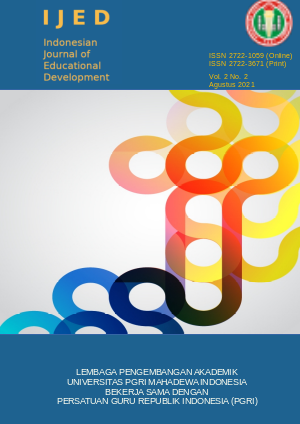Pembelajaran gerak dalam pendidikan jasmani dari perspektif merdeka belajar
DOI:
https://doi.org/10.5281/zenodo.5233331Keywords:
Movement Learning, Physical, Free LearningAbstract
Kebijakan Merdeka Belajar yang digagas oleh Menteri Pendidikan dan Kebudayaan Republik Indonesia, yaitu program belajar dengan konsep Pendidikan Merdeka. Pendidikan jasmani memanfaatkan aktivitas jasmani untuk mengembangkan dan meningkatkan komponen fisik, kognitif, dan emosional. Pelaksanaan penelitian dengan metode penelitian kepustakaan atau library research. Dengan mengkaji literatur atau artikel-artikel yang sesuai judul penelitian. Pendekatan penelitian dengan pendekatan kualitatif, dengan metode deskriptif. Pengumpulan data-data primer pada penelitian ini, dari artikel-artikel yang berkaitan dengan judul penelitian. Proses terjadinya gerak merupakan hal mendasar yang harus dipahami dimana proses terjadinya gerak pada manusia dimulai dari stimulus (S), ke reseptor (R), menuju ke otak (O). Dari otak ke syaraf motorik atau efektor (E), ke otot, tulang dan sendi sehingga terjadi gerak.
The Independent Learning Policy, initiated by the Minister of Education and Culture of the Republic of Indonesia, is a learning program with the concept of Independent Education. Physical education utilizes physical activity to develop and enhance the physical, cognitive, and emotional components. Implementation of research with library research methods or library research. By reviewing the literature or articles that match the title of the research. The research approach is a qualitative approach, with a descriptive method. The collection of primary data in this study, from articles related to the research title. The process of motion is a fundamental thing that must be understood where the process of motion in humans starts from the stimulus (S), to the receptor (R), to the brain (O). From the brain to the motor nerves or effectors (E), to the muscles, bones and joints so that motion occurs.
Downloads
References
Abduljabar. (2018). Re-orientasi pendidikan jasmani kedalam perspektif kependidikan dan kemanusiaan. Seminar Nasional Pendidikan Jasmani UMMI.
Abdulrachman. (2017). Indah seirama kinnesiologi dalam anatomi. Inteligensi Media.
Advendi, K., & Kolektus oky, R. (2020). Merdeka belajar dalam perspektif pendidikan jasmani sebagai mata pelajaran pengembangan karakter advendi. Prosiding Seminar Nasional 2020 Penguatan Pendidikan Karakter pada Era Merdeka Belajar, 12–15.
Aiman, F. dan I. K. (2020). Konsep merdeka belajar pendidikan indonesia dalam perspektif filsafat progresivisme. Jurnal Pendidikan dan Pembelajaran, 12(2 juli), 155–164. https://ejournal.unisbablitar.ac.id/index.php/konstruktivisme/index
Budiono. (2011). Anatomi tubuh manusia. Laskar Aksara.
Dafriani. (2019). Buku ajar anatomi& fisiologi untuk mahasiswa kesehatan. CV. Berkah Prima.
Dini, R. (2012). Dinamika olahraga dan pengembangan nilai (Riduwan (ed.); 1st ed.). Rineka Cipta.
Guyton, & Hall. (2011). Tex book of medical physiology. Saunders Elsevier.
Hadiputra, K. (2017). Profesionalisme tenaga profesi pendidikan jasmani,olahraga dan kesehatan. Prosiding Seminar Nasional Pendidikan Olahraga.
Hermanto. (2010). Bina gerak dan aksesibilitas. UNY Press.
Hidayat, I. (2007). Biomekanik. FPOK IKIP Bandung.
James, T., & Wahyuningtyas, P. (2012). Kepelatihan olahraga pembinaan prestasi olahraga (D. Yulianti (ed.); 2nd ed.). Cerdas Jaya.
Juliana, D. G., Widana, I. W., & Sumandya, I. W. (2017). Hubungan motivasi berprestasi, kebiasaan belajar dan minat belajar terhadap hasil belajar matematika. Emasains, 6(1), 40-60. ISSN 2302-2124.
Maksum. (2018). Metode penelitian dalam olahraga. Unesa University Press.
Mustafa, P. S., & Sugiharto, S. (2020). Keterampilan motorik pada pendidikan jasmani meningkatkan pembelajaran gerak seumur hidup. Sporta Saintika, 5(2), 199–218. https://doi.org/10.24036/sporta.v5i2.133
Mustaghfiroh, S. (2020). Konsep “Merdeka Belajar” perspektif aliran progresivisme John Dewey. Jurnal Studi Guru Dan Pembelajaran, 3(1 SE-Articles), 141–147. https://e-journal.my.id/jsgp/article/view/248
Nurul, I. (2020). Relevansi filosofi Ki Hajar Dewantara sebagai dasar. Lintang Songo: Jurnal Pendidikan, 3(2), 1–10.
Paramitha, S. T., & Anggara, L. E. (2018). Revitalisasi pendidikan jasmani untuk anak usia dini melalui penerapan model bermain edukatif berbasis alam. Jurnal Pendidikan Jasmani Dan Olahraga, 3(1), 41. https://doi.org/10.17509/jpjo.v3i1.10612
Parwata, I. M. Y. (2021). Pengaruh metode problem based learning terhadap peningkatan hasil belajar pendidikan jasmani olahraga dan kesehatan: meta-analisis. Indonesian Journal of Educational Development, 2(1), 1-9. https://doi.org/10.5281/zenodo.4781835
Rahayu, E. T. (2013). Strategi pembelajaran pendidikan jasmani. CV Alfabeta.
Resita, C. (2017). Pelatihan gerak dasar Anak Usia Dini Sekolah Paud. 20, 174–178.
Santosa Giriwijoyo, H. Y. S. (2017). Fisiologi kerja dan olahraga (1st ed.). PT Raja Grafindo Persada.
Sriwahyuniati. (2017). Belajar motorik (1st ed.). UNY Press.
Sudana, I. W. (2021). Meningkatkan motivasi dan hasil belajar siswa menggunakan metode blended learning melalui aplikasi google classroom. Indonesian Journal of Educational Development, 2(1), 38-47. https://doi.org/10.5281/zenodo.4781849
Sugiyanto, & Sudjarwo. (1996). Materi pokok perkembangan dan belajar gerak. Departeman P dan K.
Syaifuddin. (2017). Anatomi fisisiologi kurikulum berbasis kompetensi (Sk. Monika Ester (ed.); 4th ed.). EGC.
Widana, I. W. (2020). The effect of digital literacy on the ability of teachers to develop HOTS-based assessment. Journal of Physics: Conference Series 1503 (2020) 012045. https://doi.org/10.1088/1742-6596/1503/1/012045
Wijaya, & Kanca. (2019). Media pembelajaran aktivitas pengembangan PJOK untuk pendidikan dasar dan menengah. JOSSAE (Journal of Sport Science And Education), 4(1), 31-40.
Yanuar, K. (2019). Belajar keterampilan motorik (1st ed.). Prenadamedia Group.
Downloads
Published
How to Cite
Issue
Section
License
Copyright (c) 2021 I Made Yoga Parwata

This work is licensed under a Creative Commons Attribution 4.0 International License.
This is an Open Access article distributed under the terms of Creative Commons Attribution 4.0 International License, which permits use, sharing, adaptation, distribution and reproduction in any medium or format, as long as you give appropriate credit to the original author(s) and the source, provide a link to the Creative Commons licence, and indicate if changes were made. The images or other third party material in this article are included in the article's Creative Commons licence, unless indicated otherwise in a credit line to the material.

















